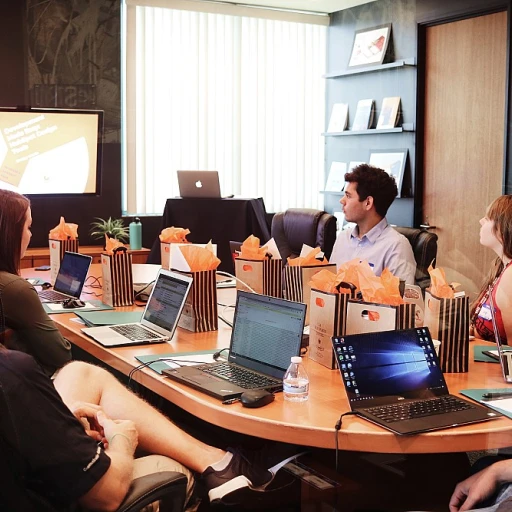
Defining Guilds in the Reskilling Landscape
Understanding the Role of Guilds in Skill Acquisition
In today's fast-paced professional landscape, the concept of guilds has re-emerged as an innovative approach to workforce development. While the root of guilds can be traced back to the medieval era, their application in modern reskilling environments is both contemporary and vital. Guilds are becoming a critical fixture in many companies' learning and development strategies, primarily catering to the needs of working adults who require career mobility and advancement. Guilds, in this context, function as collaborative learning platforms where employees can gain high-quality skills that are directly aligned with the needs of their employers. They often involve partnerships with higher education institutions and leverage employer partners to ensure the skills taught are relevant. Many companies are now incorporating guild education as an integral part of their reskilling programs, aiming to foster both employee growth and organizational success. The modern guild system can be seen as a structured community where learners, or 'students,' receive not only education but also career guidance. This intricate system is designed to allow participants to access tailored learning development opportunities matched to their career paths. Through guilds, employees have the opportunity to upskill and reskill efficiently, thereby increasing their value in the job market. Crucially, management within companies needs to recognize the importance of guilds as a tool for employee development. By investing time and resources into these programs, organizations can ensure they maintain a robust talent pipeline ready to meet the ever-evolving challenges of the industry. This not only helps in bridging skill gaps but also enhances employee retention through boosted career satisfaction. For those interested in exploring the potential of guilds within their own organizations, delving deeper into reskilling strategies is essential. Understanding how to implement such a model and measuring its success can bring significant benefits, aligning closely with effective reskilling strategies.What is Upskilling and Why is it Important?
Understanding the Importance of Skill Enhancement
In today's ever-evolving job market, the concept of "upskilling" stands out as a critical component in maintaining a competitive workforce. Upskilling involves the process of equipping employees with new skills or refining their existing abilities to meet the demands of contemporary workplaces. This is not merely an option for working adults; it is a necessity. The drive behind upskilling originates from the increasing evolution of technology and its integration into daily business operations. As businesses continue to advance technologically, the need for skilled employees becomes paramount. Competency in areas such as data analytics and digital transformation is no longer a luxury but a requirement for many roles within a company. Employers are investing in upskilling programs because they recognize how vital these efforts are for career mobility. These programs cater expressly to developing the skills employees need for current and future roles, making them an essential investment for the management and human resources departments looking to retain talent. In fact, companies that offer upskilling initiatives like guild education and tuition assistance are increasingly considered attractive employers. To keep on top of shifts in business environments, employees are encouraged to take part in education programs that provide high-quality learning development opportunities. These programs are designed not only to meet immediate company needs but also to ensure broader company success by fostering a versatile workforce. Additional offerings often include education benefits and partnerships with higher education institutions, providing paths to not only reskill but also to upskill. Upskilling also serves as a bridge for employees transitioning from high school or those seeking to pivot their career paths. By participating in structured upskilling programs, students and existing workers can access opportunities for growth that would have otherwise been out of reach. Employers play a crucial role in this endeavor by supporting initiatives and fostering a culture that prioritizes continuous learning. In summary, mastering digital skills for today's workforce is pivotal not just for the individual's career advancement but also for the long-term success of companies investing in their workforce. The time is more ripe than ever for both employers and employees to commit to these learning development efforts and ensure future readiness.Guilds vs. Upskilling: Key Differences
Comparing Two Pathways in Skills Enhancement
In the ever-evolving landscape of professional development, understanding the nuances between guilds and upskilling is crucial. Both concepts aim to empower employees but approach learning and career progression differently. Guild education is rooted in structured, collaborative environments that often resemble traditional learning models. Typically, guilds provide comprehensive education programs, supported by partnerships between employees, employers, and learning institutions. This collaboration ensures that both theoretical and practical skills are addressed, offering high-quality education to employees at various levels. Guilds, therefore, serve as a bridge between workforce needs and available talent by aligning educational content with the company's mission and goals. In contrast, upskilling focuses on enhancing existing skills through targeted, often short-term education programs. It's a flexible approach that allows employees to acquire specific competencies needed for their current roles or career advancement. Employers investing in upskilling initiatives equip their workforce with the necessary tools to adapt to new challenges. This method is particularly effective in fields requiring rapid adaptation, such as data analytics and digital proficiency. Enhancing managerial skills through performance management training is one area where upskilling can provide immediate benefits. One of the key differences lies in the delivery and duration of these programs. Guild education tends to involve long-term commitments and may be more aligned with career mobility initiatives, including higher education or tuition assistance partnerships. On the other hand, upskilling programs are integrated within existing workflows to facilitate real-time learning without significant disruption. While guilds and upskilling each have their distinct advantages, companies often benefit from a blended approach. By integrating both strategies, they ensure that their workforce is not only equipped with current, relevant skills but is also prepared for future demands. This combination can lead to a more dynamic learning marketplace, where talent development is continuously fostered and reinforced. Ultimately, the choice between guilds and upskilling will depend on the specific needs of the company, the goals they set for their workforce, and the preferred method of skill acquisition that aligns with their corporate culture and long-term strategies. Effective human resources management and clear communication channels are essential to making this decision, ensuring that every employee's career path remains aligned with their personal aspirations and the company's vision.Choosing the Right Path: Guild or Upskill?
Determining Your Career Development Approach
Choosing between guild education and upskilling programs requires an understanding of your career aspirations and the resources available to you. Both guilds and upskilling initiatives play crucial roles in strengthening workforce capabilities, yet they operate differently within the learning development ecosystem.
Guild Education often revolves around collaboration between companies and educational institutions, offering structured guild education programs designed to align with specific industry needs. This partnership guild approach facilitates seamless career mobility for working adults and high school graduates alike. With tuition assistance and high-quality education benefits, guilds provide avenues for comprehensive human resources management and talent development, ensuring that the educational pathways are directly tied to real-world applications.
On the other hand, Upskilling is typically driven by the immediate needs of the employer and the workforce. It's about enhancing current skills and acquiring new ones relevant to a specific job role or industry. This means the programs are often more flexible in time and format, aligning with the employees’ schedules. Companies investing in upskilling reskilling see it as a strategic move to retain talent, boost productivity, and stay competitive. Programs can range from data analytics courses to broader career-focused tracks, catering to the diverse needs of employers and employees alike.
Depending on your time availability, support from employer partners, and your personal career goals, you may prefer one method over the other. A guild may be beneficial for those seeking long-term educational credentials, whereas upskilling can be ideal for those looking for rapid skill development and career advancement.
Real-World Examples of Guilds and Upskilling
Illustrative Instances of Guilds and Upskilling in Action
In the evolving landscape of employee development, both guilds and upskilling programs are playing pivotal roles. These diverse approaches help management foster talent and ensure the workforce remains competitive.Guild Model Implementation A striking example of a structured guild model can be found in the high tech industry, where companies have partnered with guild education platforms to provide employees with dedicated pathways toward career advancement. Such guilds often offer programs in data analytics, allowing talent to develop skills aligned with emerging market needs. By doing so, companies can bolster their internal workforce while benefiting from sustained talent development.
Upskilling Initiatives in Action On the other hand, many organizations are investing in upskilling initiatives focused on continuous learning. A noted instance involves a renowned multinational company that launched a robust upskilling program encompassing education learning opportunities for working adults. Through tuition assistance and diverse education benefits, employees can enhance their career mobility and adapt to the dynamic demands of current industry trends.
Combining Models for Maximum Impact Interestingly, some employers are leveraging both guilds and upskilling strategies, creating a learning marketplace within the organization. By doing so, they not only improve employee satisfaction but also ensure their workforce is prepared for future challenges. This dual approach aligns with the broader trend of integrating human resources with learning development to support long-term company goals.
These real-world examples underscore the importance of adopting flexible and high quality education frameworks, encouraging both students and employer partners to navigate the evolving job market successfully. They also highlight how investing time and resources in career and skills enhancement can yield significant returns for both the individuals and the organizations involved.













